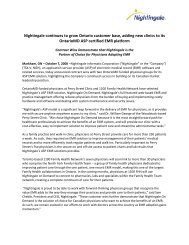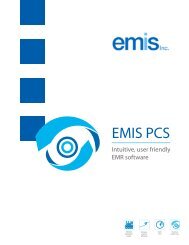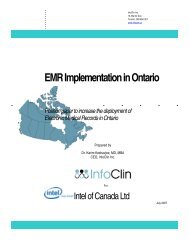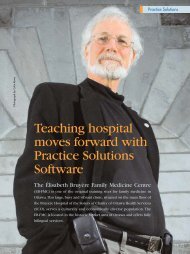Calgary, Alberta Dr. Norman Yee Family Health ... - CanadianEMR
Calgary, Alberta Dr. Norman Yee Family Health ... - CanadianEMR
Calgary, Alberta Dr. Norman Yee Family Health ... - CanadianEMR
You also want an ePaper? Increase the reach of your titles
YUMPU automatically turns print PDFs into web optimized ePapers that Google loves.
Reprinted from Future Practice, a CMA PublicationAhead of the curve<strong>Dr</strong>. <strong>Norman</strong> <strong>Yee</strong><strong>Family</strong> <strong>Health</strong> Clinic<strong>Calgary</strong>, <strong>Alberta</strong><strong>Family</strong> physicianmakes the casefor the EMRSpecialty: Primary care with1 rheumatologist on staffPractice type: Large group<strong>Dr</strong>.<strong>Yee</strong> is a family physician at the <strong>Family</strong> <strong>Health</strong> Clinic in <strong>Calgary</strong>.The clinic has eight family physicians, one rheumatologist, aclinic manager and two full-time and four part-time office staff.<strong>Dr</strong>. <strong>Yee</strong> is involved in <strong>Alberta</strong>’s Physician Office System Program (POSP).DWAYNE BROWNUsing an EMR for 6 yearsLocation: <strong>Calgary</strong>, Alta.(pop. 1,070,000)Why an EMR?<strong>Dr</strong>. <strong>Yee</strong>’s interest in information technology and his family businessbackground helped him see the “business case” — the economic andpractice benefits — of using an EMR and positioned him to lead theclinic’s decision-making and implementation process. Group consensus14 FUTURE Practice 6 January 2009
Ahead of the curvewas achieved once everyone understood the benefits of anEMR; the potential to increase staff and physician efficiencywas particularly attractive.The clinic began using an EMR in 2002. When theoriginal vendor went out of business, the clinic switchedto an EMR product supported by POSP.Making the moveThis clinic was successful in implementing its EMRbecause of a number of factors: motivated leadership,good change management, an appropriate budget andhaving a clinic manager to oversee the process.Without <strong>Dr</strong>. <strong>Yee</strong>’s leadership, EMR implementationlikely would not have occurred when it did, nor been assuccessful. In his words, “You need somebody who willtake charge, provide the vision, provide the ongoing businesscase, provide the ongoing champion. That’s how itgets done. It’s very much a pull, and often a push. Left totheir own devices, groups will not move.”Change management began with understanding ofthe existing workflow and how an EMR would affect it.EMR featuresIn use:• billing• scheduling appointments• intraoffice communication• entering patient encounter notes• generating and recording prescriptions• generating referral or consultation letters• ordering diagnostic tests• downloading and direct import of lab results• generating and maintaining patient summaries• generating patient reminders• scanning and storage of documents• remote access• access to other information systems• PIN: <strong>Alberta</strong>’s Pharmaceutical InformationNetwork• PACS: Picture Archiving and CommunicationSystem for CT and ultrasound images• ADT: admissions/discharge/transferdata from hospitals• electronic communication of patient informationto other facilities• electronic receipt of patient information fromother facilities• clinical decision support toolsNot in use:• capturing and storage of x-ray images** No available interface from diagnostic imaging facilitiesin the area.The physicians investigated various software products andselected the one that best fit their needs. The clinic preparedfor implementation by training personnel andmaking necessary space modifications, including wiringand furniture, that supports computer use in the examroom without interfering in the physician-patientencounter.Another factor in this success story was the clinicmanager, who was able to see the “big picture.” Physiciansdo not generally have the experience in business practicesand organizational management that a management professionalcan offer.Finally, budgeting appropriately contributed to theclinic’s success. The budget not only included the EMRsoftware and physical modifications, but also consideredfuture requirements such as ongoing updates andupgrades.Working with the EMRBenefitsThe most obvious change is the decrease in the movementof paper. Use of the EMR means staff and physicians donot have to handle paper charts and move them aroundthe office. Workflow is simplified, as physicians accesscomprehensive patient information from any workstationand staff do not need to get up to look for charts whenresponding to information requests. A major organizationalimpact of the EMR has been the reassignment, notloss, of support staff.Communication within the office also changed. Staffuse the EMR’s messaging system to send questions andinstructions, rather than writing notes by hand and bringingthem to each other, and urgent requests are flagged forimmediate attention.The EMR has not changed the goal of patient consultation— just the means by which physicians accessand document patient information. The patient is stillthe primary focus; the EMR enhances the interaction andmakes it easier to provide quality care and patient education.Important information is available immediately, andthe patient can more easily view lab results and trends.It is easier to get information relevant to patient care. IfI need to look up a particular issue or dosage, I can dothat with a few keystrokes, and the patient sees whatI’m doing. I think that’s improved confidence. They arealso acutely aware that I’m capturing their experienceand concerns at the time, as they can hear me typing.And they know that I’m paying attention to them, andthat my information is going into some magicalcomputer system, which is tracking everything.6 January 2009 FUTURE Practice 15
Ahead of the curveChallengesWhile the clinic underwent vendor-supplied trainingbefore 2002 implementation of the EMR, <strong>Dr</strong>. <strong>Yee</strong> reflectsthat they should have spent more on training — andextended that training over a longer period. Training wasconcentrated in the pre-implementation stage, but theymay have benefited from refreshers and instruction onadvanced features after a few months of using the system.When the practice switched EMR systems in 2008, inhousetraining started before implementation and continuedat two, four and six months after.Moving forwardIn the future, <strong>Dr</strong>. <strong>Yee</strong> plans to use more of the data-miningand population health management features of their newEMR software. He sees these functions as an opportunityto provide better patient care.Population management means that you look at thepopulation of the practice and query the database fora variety of conditions. Then you can make decisionsbased on that. The population management modulethat we’re getting is even more powerful. It gives youthat level of functionality on an automated basis, sothat you can create a series of parameters for whichyou want a measurement. And it will, on a daily ora weekly basis, run itself to generate the list.<strong>Dr</strong>. <strong>Yee</strong>’s wish list for the future also includes interactivepatient information, greater interoperability betweenproviders and more and faster access to existing databases.To read more about how this clinic uses the EMR, the full case studyreport is available online at cma.ca/EMRcasestudies.Key lessons and advice• On information management:I think it’s incumbent on physicians and other clinicians to recognize that information management is [alarge part of] what they do and, therefore, they need information management tools and that that oughtto be a very big block of their educational curriculum.• On change management:The biggest lesson: change management, change management, change management. It’s like painting aroom in your house: it’s all in the prep. The painting part is actually easy. It doesn’t even take long. But,boy, if you haven’t prepped it properly, you’ll find out pretty quickly where all the problems are, becausethat’s where all the paint will spill.16 FUTURE Practice 6 January 2009








